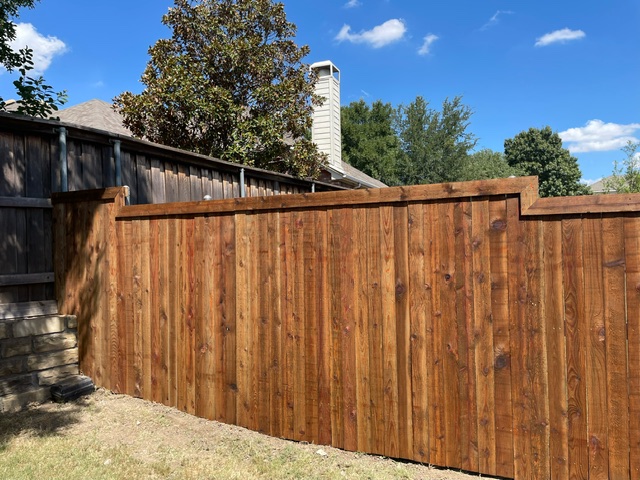Wood Fence Maintenance Guide: Tips from the Pros
Here at DFW Fence Pro, we’ve seen it all when it comes to wooden fences. From the pristine new installations to the weathered veterans that have protected homes for decades. A well-maintained wood fence doesn’t just boost your property’s curb appeal—it provides security, privacy, and that warm, natural aesthetic that other fencing materials simply can’t match.
But let’s be honest: wood fences in the Dallas-Fort Worth area take a beating. Between our scorching summers, occasional storms, and persistent humidity, your fence faces challenges that demand attention. The good news? With proper care, your wooden boundary can stand strong for 15+ years. Let’s dive into how to make that happen.

The Fundamentals of Wood Fence Maintenance
We recommend walking your fence line at least twice a year—ideally in spring and fall. Look for warped boards, protruding nails, loose posts, and any signs of rot or insect damage. Small issues caught early can prevent costly repairs later.
During your inspection, pay special attention to areas where water might collect, like around the base of posts or where fence sections connect. These moisture-prone spots are where problems typically begin.
Cleaning: More Than Just Appearances
Your fence isn’t just collecting dust—it’s accumulating mold, mildew, and environmental debris that can accelerate deterioration. A good cleaning every 12-18 months works wonders for extending your fence’s life.
For best results, we use a mixture of warm water and mild soap, applying it with a soft-bristled brush. For tougher spots, a solution of one part bleach to ten parts water can remove stubborn mildew—just be careful around your plants! After cleaning, allow the fence to dry completely before applying any treatments.
Sealing and Staining: The Protective Shield
Texas weather is relentless on untreated wood. We’ve found that applying a quality water-repellent sealer or stain every 2-3 years dramatically extends fence life by preventing moisture absorption.
When selecting a product, look for one with UV protection to prevent the silvery-gray discoloration that comes from sun exposure. Oil-based stains penetrate deeper and typically offer better protection than water-based alternatives for our climate.
The best time for application? Choose a few dry days with moderate temperatures—not during the peak of summer heat when the product might dry too quickly and not bond properly.
Addressing Common Wood Fence Problems
A slightly leaning fence isn’t just an eyesore—it’s a structural warning. In our experience, leaning usually stems from one of three issues:
- Post foundation failure (concrete footing cracked or shifted)
- Rotted posts no longer providing adequate support
- Soil erosion around the posts
For minor leaning, we sometimes can brace and straighten the section, reinforcing the post with additional concrete. For more severe cases, post replacement might be necessary.
Fighting Back Against Rot
Wood rot is like a cancer for your fence—it spreads if not addressed. When we spot small areas of rot, we’ll carefully remove the damaged wood and treat surrounding areas with a borate solution to prevent spread. For localized damage, wood hardener products can sometimes save a board that’s beginning to soften.
Handling Broken or Damaged Boards
The occasional broken picket or rail is inevitable. Fortunately, individual board replacement is straightforward for most wooden fence styles. We recommend keeping a few extra boards from your original installation (or matching them as closely as possible) for these situations.
When Wood Fence Repair Isn’t Enough: Signs It’s Time for Replacement
After working with thousands of fences across the DFW metroplex, we’ve identified key indicators that signal replacement time has arrived. If you can easily push a screwdriver into multiple boards or posts with minimal pressure, the wood has lost its structural integrity. Spot replacements might work temporarily, but comprehensive degradation calls for a fresh start.
Furthermore, finding yourself calling for repairs several times a year? This pattern usually indicates systemic failure beginning throughout the fence system. Like an old car requiring constant maintenance, there comes a point where replacement becomes the more cost-effective choice.
Moreover, even with perfect maintenance, most wooden fences in our climate have a practical lifespan of 15-20 years. If yours has reached this milestone, congratulations on maximizing its potential! But be prepared for increasing issues as the natural materials continue to break down. Then, when no amount of cleaning, staining, or individual board replacement can restore a uniform appearance, it might be time to consider starting fresh. A new fence provides the opportunity to incorporate updated designs and potentially more durable materials.
Partnership in Protection
Whether maintaining your current wooden fence or planning for a replacement, we at DFW Fence Pro are here to help every step of the way. Our experience across the Dallas-Fort Worth area has taught us that proactive maintenance isn’t just about preserving an investment—it’s about maintaining the beauty, security, and value of your property.
Remember that your fence serves faithfully every day, through every season. With proper care, it will continue to enhance your outdoor living experience for years to come. When the time eventually arrives for replacement, view it as an opportunity to improve upon what came before.Have questions about your specific fence situation? Contact our team for a personalized assessment—because when it comes to wood fences, an expert eye can make all the difference.
